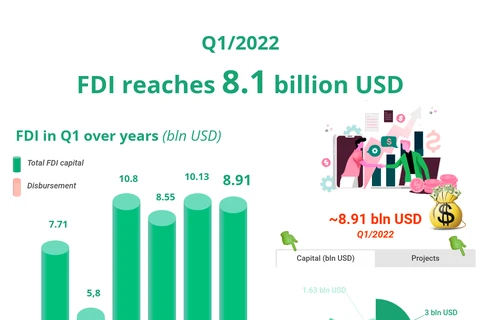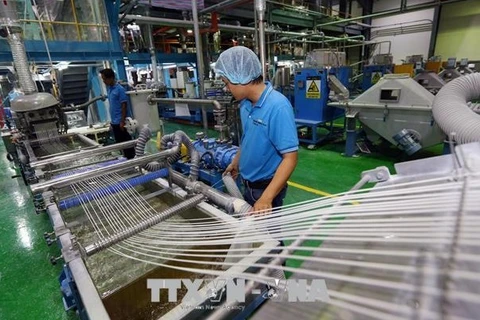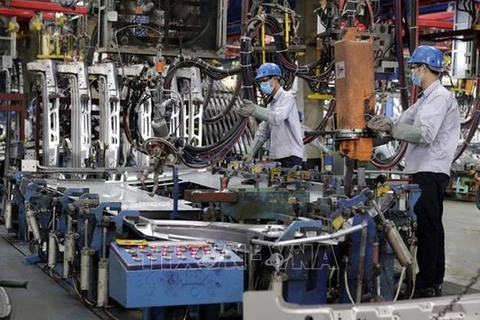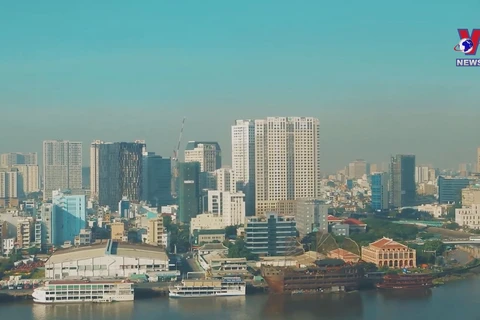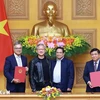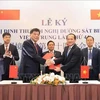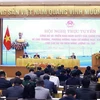 Delegates at a conference announcing an annual report on foreign investment in Vietnam held by VAFIE on May 10. (Photo: Vietnamplus)
Delegates at a conference announcing an annual report on foreign investment in Vietnam held by VAFIE on May 10. (Photo: Vietnamplus) Hanoi (VNA) - World economic growth is slowing, global foreign direct investment (FDI) may decline. In addition, competition to attract FDI is increasingly fierce, so it is difficult for Vietnam to achieve the goal of quality and socio-economic efficiency without screening high quality FDI projects.”
The statement was made by Professor, Doctor Nguyen Mai, President of the Association of Foreign Investment Enterprises (VAFIE) at a conference announcing the "Annual report on foreign investment in Vietnam," organized by VAFIE on May 10.
Goals for quality FDI
Resolution 50-NQ/TW dated August 20, 2019 of the Politburo sets out the objectives of attracting FDI in the period 2021-2025 with a registered capital of 150-200 billion USD and implementation capital of 100-150 billion USD. The figures for the period of 2026-2030 are 200-300 billion USD and 150-200 billion USD.
In terms of quality, the proportion of enterprises using advanced technology, modern governance, environmental protection, aiming at high technology hopes to increase by 50%. While the proportion of trained workers is to increase by 70%, the proportion of localization is to increase by 30% by 2025 compared to 2018.
In addition, the Party and the State seek to advocate to attract FDI into the green economy as well as the green technology transfer process (in the National Strategy for Green Growth).
Prof. Nguyen Mai said that the quantity target set in the Resolution is completely possible on the basis that Vietnam has stable political and macroeconomic institutions with a market of nearly 100 million people and a growing middle class. In addition, the investment and business environment is increasingly improved and deeply integrated internationally. Moreover, Vietnam has many conditions for investors to reduce transportation costs and connect the global supply chain.
The report also points out that the majority of foreign investors considers Vietnam as an attractive market for sale and merger (M&A) in 2022 and the following years.
“In fact, in 2021, the world economy and global FDI as well as the domestic economy are negatively affected by the COVID-19 pandemic but attracting foreign investment and FDI sector activity still shows encouraging results and is rated a bright spot in the economic panorama of Vietnam,” the professor said.
According to the report, Vietnam is the third largest recipient of FDI in the region and one of the ASEAN countries that has maintained stable FDI flow growth over many years. Specifically, in 2021, the registered capital reached 31 billion USD, increased 9% and the implemented capital reached nearly 20 billion USD, a slight decrease of 1% compared to 2020. Cumulatively, by December 20, 2021, Vietnam has attracted 408 billion USD with over 35,500 FDI projects in force. The disbursed capital reached 251 billion USD, reaching 62% of the total registered capital.
Contributions not commensurate with the incentives granted
However, in terms of quality of foreign investment projects to present, the report showed that there are many shortcomings to overcome.
In fact, the number of high-tech projects from developed economies (such as the US and Europe) into Vietnam is relatively small, while the number of enterprises establishing R&D centers is still insignificant. Specifically, the number of projects with modern technology, technology originating from the United States and Europe only accounts for 5%, average technology accounts for 80%, and older technology accounts for 15%.
The FDI economic sector is an important driver of growth. But contribution to the State budget from many FDI enterprises is not commensurate with the project size as well as the incentives they receive from the government.
On the other hand, the structure of FDI by region and locality is still disproportionate. FDI projects are concentrated mainly in areas with favorable conditions such as the Southeast region, the Red River Delta and some major provinces and cities with high levels of socio-economic development./.
